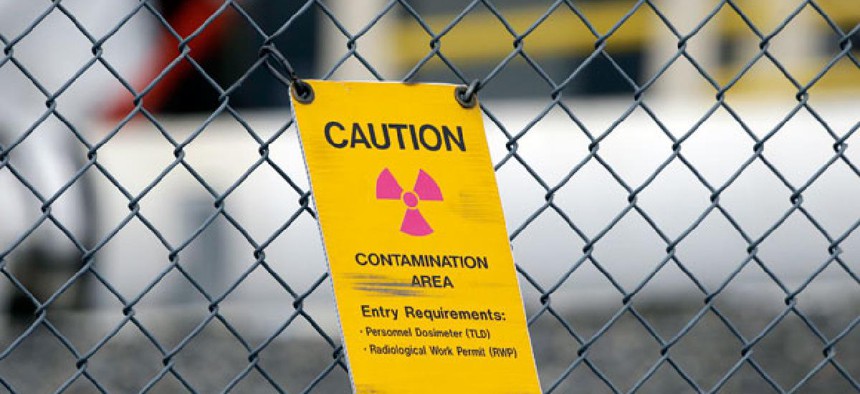Nuclear Waste Tank at Hanford Site May Be Leaking, Officials Say

A sign warning of radioactive contamination dangles from a fence at the 'C' Tank Farm at the Hanford Nuclear Reservation. Ted S. Warren/AP
Elevated radiation levels represent “most disturbing news,” governor says.
Washington Governor Jay Inslee warned state residents on Friday that a tank designed to safely store 1 million gallons of nuclear waste at the Energy Department’s Hanford Site may have sprung a leak. The site is five miles from the Columbia River.
Inslee said Energy Secretary Ernest Moniz informed him June 20 that the department “discovered what appears to be an elevated contamination level reading in the leak detection pit outside and adjacent to the Hanford double-shell tank AY-10.” Inslee characterized this as “most disturbing news for Washington.”
“It is not clear yet whether that contamination is coming directly from the outer shell of the AY-102 but it must be treated with the utmost seriousness,” Inslee said.
A legacy of the crash project to develop the atomic bomb in World War II, the 586-square-mile Hanford Site contained nine reactors that produced plutonium through the 1980s, with much of the waste dumped into trenches, wells or single-shell tanks in the 1940s. In 1971, Energy began installing 28 double-shell tanks designed to contain leaks in the walls between the shells.
Inslee said DOE plans to conduct an engineering analysis of the potentially leaky tank. “Given the relatively early detection of this potential leak, the [Columbia] river is not at immediate risk of contamination should it be determined that a leak has occurred outside the tank,” he said.
Lori Gamache, a spokeswoman for Energy’s Office of River Protection in Richland, Wash., said in an emailed statement that the department “has been actively monitoring double-shell tank AY-102 since it was discovered to have a slow leak from the primary tank. On Thursday, June 20, 2013, workers detected an increased level of contamination during a routine removal of water and survey of the leak detection pit.”
That could indicate a leak from the second shell. “However, further assessment must be completed before a determination can be made regarding the contamination source, “Gamache said.
On June 14, the Office of River Protection submitted a plan to the nuclear waste program office in the Washington Department of Ecology to empty tank AY-102, but not until 2019.
If the heightened radiation is found to result from leaks in tank AY-102, the Energy department will pump the liquid material from the tank. "The Office of River Protection is already beginning the process to put the necessary infrastructure in place to do so," Moniz said in a statement. This approach would still leave solid wastes in the tank.
Tom Carpenter, executive director of Hanford Challenge, a Seattle-based watchdog group, said his organization first reported a leak from the inner tank of AY-102 in August 2012, a fact that DOE did not acknowledge until October 2012.
He said waste found last week in the leak detection pit was radioactive, which indicates a leak in the outer shell. He called for Energy to empty the tank now -- not in 2019 -- before radioactive waste could enter groundwater and make its way to the Columbia River.
DOE plans to process the 56 million gallons of waste stored in the 28 double-shell tanks and 149 single-shell tanks into glass logs in a facility built for the purpose. Bechtel National Inc. is building the Waste Treatment and Immobilization Plant under a contract valued at $4.3 billion when it was awarded in 2000. It was to be completed in 2011.
The Government Accountability Office reported in December 2012 that the cost of the plant had almost tripled to $12.3 billion, with completion now estimated in 2019 -- a deadline Carpenter believes won’t be met.
Energy has spent $36 billion on cleanup efforts at the Hanford Site. Carpenter estimated it could cost as much as $150 billion to operate the still unproven Waste Treatment and Immobilization Plant. He wants the department to build better storage tanks and Congress to increase oversight.
Carpenter characterized the current situation as an “underground Chernobyl waiting to happen.”
NEXT STORY: I’m Very PTSD Aware






